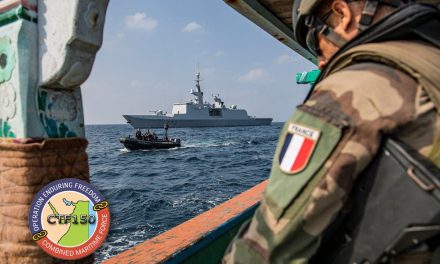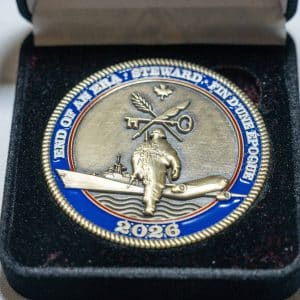
Members of Fleet Diving Unit (Pacific) stand around the entry and exit hole on an ice diving expedition at Lac Des Roches, north of Kamloops.
After suiting up in a drysuit, Clearance Diver LS Hector Ladron De Guevara slipped feet first into the icy waters of Lac Des Roches, just North of Kamloops, B.C.
For almost an hour he explored the underwater terrain, going as far as his 45-metre umbilical cable would allow. Above him, a frosty pane of ice served as a lid on the lake. His only way out, a hole carved through the ice.
The sailor, a member of Fleet Diving Unit (Pacific), took part in this ice diving excursion with 18 other divers. They set up a temporary camp on the ice Feb. 15; their goals: skill development and proficiency training.
Lac Des Roches was picked due to its notoriously solid ice build this time of year.
A four hour set up preceded the dives, during which three members, all wearing life jackets, went out to the middle of the lake to test for ice thickness.
The front individual, wearing a harness, dug a hole and measured the thickness. When the minimum six inches of ice was found, the trio cut a triangular hole through the ice using a chainsaw.
Once the hole was cut, the remainder of the team ventured from the shore to set up a military tent around the triangle to protect divers and gear from the wind and weather.
LS Ladron De Guevara said the newer divers enjoyed their first forays into ice diving while the more experienced divers honed skills and refined equipment requirements for the labour intensive activity, one necessary for rescue or retrieval missions.
Divers entered the water in teams of two, wearing a full-face mask supplied with breathing gas by a 45-metre hose (umbilical), which also includes communications ability.
Each diver also had an emergency air tank to get him to the surface if his umbilical failed.
“The umbilical is our air hose,” LS Ladron De Guevara says. “It’s our lifeline.”
Dry suits, rather than wetsuits, were used to keep the divers as warm as possible.
“It was just a little colder than the ocean,” says LS Ladron De Guevara. “But you can definitely feel it.”
Because divers are connected to their air supply at the surface, the duration of the dive is not limited by what breathing air the diver is carrying.
Most divers on the trip opted to stay under for about 30 minutes, or for as long as their supervisor dictated.
In case of an emergency, there was a team of support on the surface ready to assist, including a standby diver at the entry point who stood ready to enter the water if one, or both, of the divers signaled distress.
As an extra precaution, the standby diver’s umbilical reached a length of 60 metres, meaning he was able to swim past the distance regular divers are afforded.
“The amount of support we have for that kind of diving makes it some of the safest diving out there,” says LS Ladron De Guevara.
He felt comfortable using the full length of his umbilical, which he used to make wide circles in the water around the entry and exit hole.
“Once in the water, I had relatively good visibility – about 15 or 20 feet,” he says. He attributes this to the ice above, which allowed for more sunlight to reach the water.
Given his extensive experience diving in open water, he says being able hear the ice on the lake cracking and adjusting was a surprise.
“It’s a really deep sound. You can see the cracks in the ice, and where your air bubbles are channeling after you breathe out.”
Unlike ocean diving, LS Ladron De Guevara says ice diving is slightly more restrictive, considering the fact that divers can’t surface in the way they are used to.
“With this, there is only one way in and one way out,” he says.
“There’s no way to break the ice. If there was a problem with our system, we couldn’t surface.”
After four days of taking turns exploring the lake, the team wrapped up their expedition on February 19, heading back to CFB Esquimalt with their newly
polished skills.
Rachel Lallouz
Staff Writer









